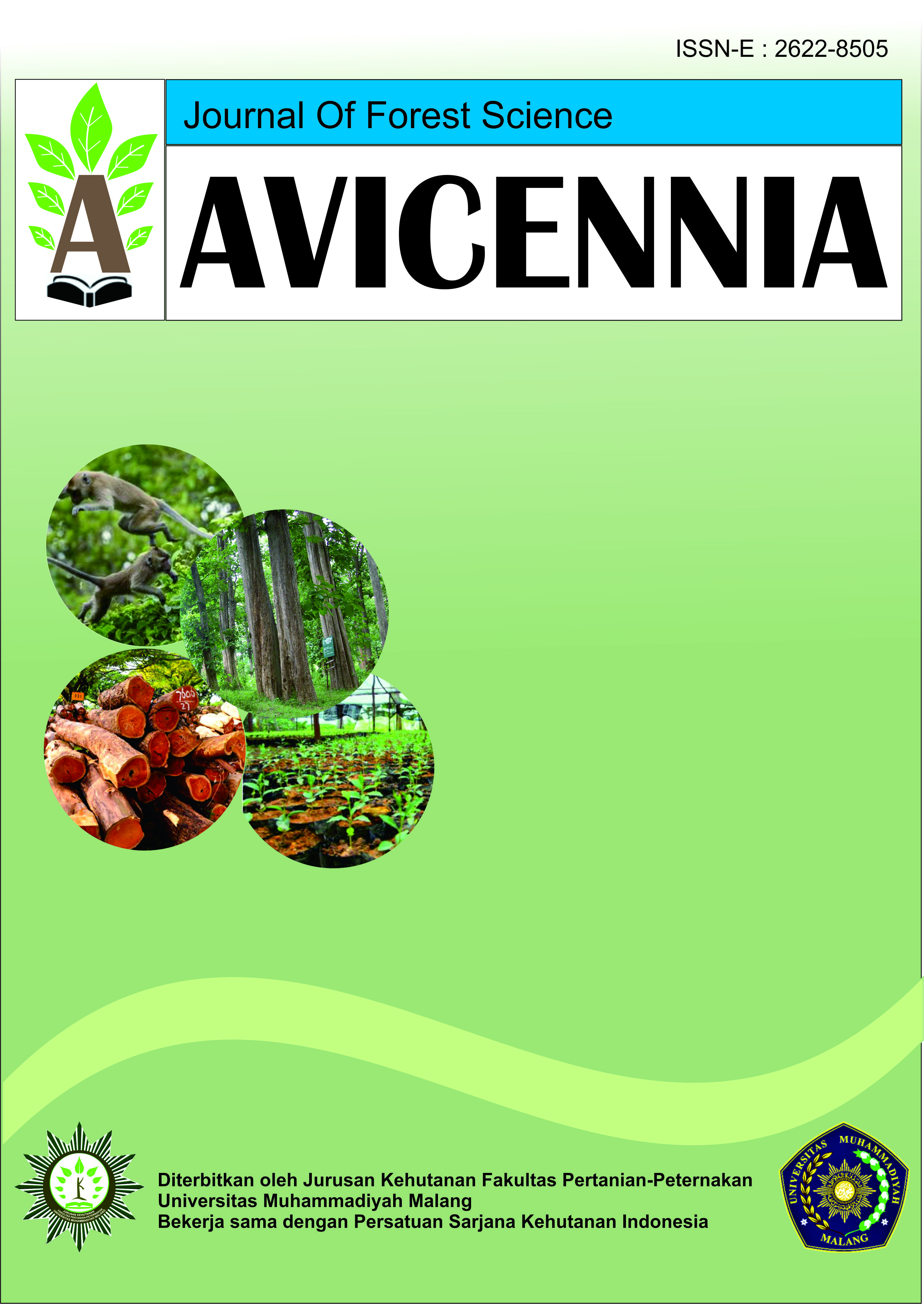Kepuasan Dan Persepsi Wisatawan Terhadap Keberlanjutan Taman Nasional Gunung Ciremai
DOI:
https://doi.org/10.22219/avicennia.v5i1.19996Keywords:
Kawasan konservasi, wisata, keberlanjutanAbstract
Kawasan konservasi dirancang untuk melestarikan alam berikut keanekaragaman hayati dan proses ekosistem yang mendukungnya serta untuk menjadi wahana pendidikan lingkungan. Guna mencapai tujuan tersebut program wisata alam dibuka di berbagai kawasan konservasi, termasuk di Taman Nasional Gunung Ciremai. Selain dapat menambah pendapatan, program wisata alam di TNGC juga dapat memberikan dampak positif bagi masyarakat lokal dan wisatawan. Penelitian ini bertujuan untuk mengetahui hubungan kepuasan dan persepsi wisatawan terhadap keberlanjutan Taman Nasional Gunung Ciremai.
Penelitian dilakukan dengan melakukan survey online dengan menggunakan google form. Desain kuisioner dirancang untuk mengetahui 3 (tiga) variable, yakni sosial demografi, kepuasan dan persepsi terhadap keberlanjutan Taman Nasional Gunung Ciremai. Variabel kepuasan dan persepsi diukur dengan skala likert dengan rentang 1-5. Analisis data dilakukan dengan menggunakan analisis deskriptif dan uji korelasi spearman.
Hasil penelelitian menunjukkan adanya hubungan positif dan searah (rs=0,816) antara kepuasan wisatawan dengan persepsi keberlanjutan TNGC. Penelitian ini dapat digunakan sebagai dasar bagi pengelola kawasan untuk mengembangkan rencana pengelolaan terkait dengan penguatan aspek keberlanjutan guna meningkatkan kepuasan wisatawan.
Downloads
References
Atiqul Haq, S. M. (2016). Multi-benefits of national parks and protected areas: an integrative approach for developing countries. Environmental & Socio-economic Studies, 4(1), 1–11. https://doi.org/10.1515/environ-2016-0001
Bushell, R., & Bricker, K. (2017). Tourism in protected areas: Developing meaningful standards. Tourism and Hospitality Research, 17(1), 106–120. https://doi.org/10.1177/1467358416636173
Cottrell, S., Van der Duim, R., Ankersmid, P & Kelder, L. (2004). Measuring the Sustainability of Tourism in Manuel Antonio and Texel: A Tourist Perspective. Journal of Sustainable Torusim, 12:5, 409-431,doi:, 10.1080/09669580408667247
Drumm, A. (2008). The threshold of sustainability for protected areas. BioScience, 58(9), 782–783. https://doi.org/10.1641/B580902
Hardy, A., Beeton, R. J. S., & Pearson, L. (2002). Sustainable tourism: An overview of the concept and its position in relation to conceptualisations of tourism. Journal of Sustainable Tourism, 10(6), 475–496. https://doi.org/10.1080/09669580208667183
Hiwasaki, L. (2006). Community-based tourism: A pathway to sustainability for Japan’s protected areas. Society and Natural Resources, 19(8), 675–692. https://doi.org/10.1080/08941920600801090
Hu, H.-H., Kandampully, J., & Juwaheer, T. D. (2009). Relationships and impacts of service quality, perceived value, customer satisfaction, and image: an empirical study. The Service Industries Journal, 29(2), 111-125.
Jain, N. and R. Triraganon. 2003. Community-based tourism for conservation and development: A training manual. Washington, DC, and Bangkok, Thailand: The Mountain Institute and RECOFTC
Mihanyar, P., Rahman, S. A., & Aminudin, N. (2016). Investigating the Effect of National Park Sustainability on National Park Behavioral Intention: Kinabalu National Park. Procedia Economics and Finance, 37(16), 284–291. https://doi.org/10.1016/s2212-5671(16)30126-5
Millenium Ecosystem Assesment. (2005). Ecosystem and Human Well-being: Synthesis, Island Press, Washington, DC
Oviedo-García, M. Á., Vega-Vázquez, M., Castellanos-Verdugo, M., & Orgaz-Agüera, F. (2019). Tourism in protected areas and the impact of servicescape on tourist satisfaction, key in sustainability. Journal of Destination Marketing and Management, 12 (February), 74–83. https://doi.org/10.1016/j.jdmm.2019.02.005
Said, Jurmin & Maryono. (2017). Motivation and Perception of Tourists as Push and Pull Factors to Visit National Park. E3S Web of Conferences. 31. https://doi.org/10.1051/e3sconf/20183108022
Schirpke, U., Scolozzi, R., Da Re, R., Masiero, M., Pellegrino, D., & Marino, D. (2018). Recreational ecosystem services in protected areas: A survey of visitors to Natura 2000 sites in Italy. Journal of Outdoor Recreation and Tourism, 21(August 2017), 39–50. https://doi.org/10.1016/j.jort.2018.01.003
Sugiyono. 2019. Statistika untuk Penelitian. Bandung: Penerbit Alfabeta
Sutton, P. (2004). A Perspective on environmental sustainability ?
Swingland and Russell. (1999). In Integrated Protected Area Management (Vol. 6). https://doi.org/10.1007/978-1-4615-5279-6
Taman Nasional Gunung Ciremai. (2016). (2016). Ringkasan Eksekutif: Menuju Manajemen Paripurna Pengelolaan Taman Nasional Gunung Ciremai Untuk Kedaulatan Rakyat. Dirjen KSDAE, Kementerian Kehutanan dan Lingkungan Hidup
Taman Nasional Gunung Ciremai. (2019). Statistik Balai Taman Nasional Gunung Ciremai Tahun 2018. Dirjen KSDAE, Kementerian Kehutanan dan Lingkungan Hidup.
Downloads
Published
Issue
Section
License
Copyright (c) 2022 Adi Nugroho, Denni Susanto, Prasetyo Nugroho

This work is licensed under a Creative Commons Attribution 4.0 International License.
Authors who publish with this journal agree to the following terms:
- Authors retain copyright and grant the journal right of first publication with the work simultaneously licensed under a Creative Commons Attribution License that allows others to share the work with an acknowledgement of the work's authorship and initial publication in this journal.
- Authors are able to enter into separate, additional contractual arrangements for the non-exclusive distribution of the journal's published version of the work (e.g., post it to an institutional repository or publish it in a book), with an acknowledgement of its initial publication in this journal.
- Authors are permitted and encouraged to post their work online (e.g., in institutional repositories or on their website) prior to and during the submission process, as it can lead to productive exchanges, as well as earlier and greater citation of published work (See The Effect of Open Access).











